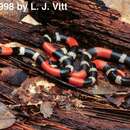en
names in breadcrumbs


Venezuela, northern parts of Fuyana, Surinam, French Guiana and Brazil (Amapá, Pará, Rondonia); Trinidad.
Syntypes (2): NHRM L-93 and L-94. NHRM L-93 designated lectotype by Roze, 1989, Am. Mus. Novit. 2932:1-15[14].
Type-locality: Asia (in error, according to Roze, 1989, Am. Mus. Novit. 2932:1-15[14].) Restricted to Belém, Pará, Brazil, by Schmidt and Walker, 1943, Field Mus. Nat. Hist. Publ., Zool. Ser. 24:279-296[294]; subsequently, restriction considered invalid by Roze, 1967, Am. Mus. Novit. 2287:1-60[32], because the locality lies outside the known distribution of M. l. lemniscatus.
Five subspecies, namely M. l. lemniscatus (Linnaeus, 1758); M. l. carvalhoi Roze, 1967; M. l. diutius Burger, 1955; M. l. frontifasciatus (Werner, 1927); and M. l. helleri Schmidt and Schmidt, 1925, were recognized by Roze, 1967, Am. Mus. Novit. 2287:1-60[32-35], but M. l. frontifasciatus was elevated to species status by Roze, 1983 [dated 1982], mem. Inst. Butantan 46:305-338[313].
Micrurus lemniscatus, commonly known as the South American coral snake, is a species of venomous snake in the family Elapidae. The species is endemic to South America.[2]
M. lemniscatus is a thin and brightly colored species. Adults measure 60–90 cm (24–35 in) in length, the maximum previously reported was 145 cm (57 in). The snout is black, followed by a narrow white crossband in front of the eyes, then a wider black band including the eyes. The eyes are small, and the rest of the head is red. The body pattern consists of slightly broad red rings that are separated by seven to 17 triads of three black and white rings. The tail has two black triads alternating with white rings.
Like many coral snakes, M. lemniscatus is nocturnal and terrestrial, digging in loose soil or litter. It is not aggressive towards humans, although it can attack to defend itself.[3]
Breeding of M. lemniscatus is oviparous, having a clutch size of possibly 20 eggs.[3]
Alimentation of M. lemniscatus is mainly long-bodied vertebrates such as freshwater eels, gymnotiform fishes, caecilians, lizards, and snakes.[1][3][4]
M. lemniscatus is found in Argentina, northern Bolivia, Brazil, Colombia, eastern Ecuador, French Guiana, Guyana,[5] Paraguay, eastern Peru, Suriname, Trinidad, and Venezuela.[2]
M. lemniscatus is a widespread species in South America, living in humid forests and lowland forests, in open savannas and gallery forests. It is also found in lowland floodplains, deforested areas or near human habitation, in humid areas or near places with a water source. It occurs from near sea level to an altitude of 1,000 m (3,300 ft).[3]
The venom of M. lemniscatus is a potent post- and pre-synaptic neurotoxin, which causes a potent and irreversible neuromuscular block in vertebrates.[6] Lemnitoxin, a potent myotoxic PLA2 type toxin, isolated from the venom of M. lemniscatus induces local and systemic myotoxicity after intramuscular and intravenous injection in mice, which is antigenically related to Micrurus nigrocinctus nigroxin, Notechis scutatus notexin, mulgotoxin of Pseudechis australis and textilotoxin of Pseudonaja textilis.[7]
{{cite journal}}: CS1 maint: uses authors parameter (link) Micrurus lemniscatus, commonly known as the South American coral snake, is a species of venomous snake in the family Elapidae. The species is endemic to South America.